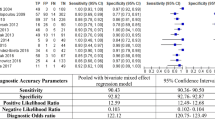Abstract.
The primary objective of this review was to assess the diagnostic accuracy of voiding urosonography (VUS) in detecting reflux (VUR). As a secondary objective, the reported technical suggestions and diagnostic mistakes were shown to improve the examination protocol and provide the most accurate results. Using a Medline Database search, the published articles comparing the grey-scale (GS) or colour-Doppler (CD) VUS with voiding cystourethrography (VCUG) as the gold standard were selected. Articles were excluded when data were not sufficient to construct 2×2 tables or when the gold standard was different from VCUG. For the analyses of diagnostic accuracy values, 95% confidence intervals were given. Agreements in the results of GSVUS and VCUG and in those of CDVUS and VCUG were determined by Kappa statistics. GSVUS and CDVUS were compared for diagnostic accuracy by the McNemar test. Results showed that the range of GSVUS sensitivity and specificity in detecting VUR was 69%–100% and 86%–97%, respectively. The agreement between GSVUS and VCUG diagnoses ranged from 90% to 97% (K score range 0.61–0.92; P<0.001). The range of CDVUS sensitivity and specificity in detecting VUR was 93%–100% and 86%–93%, respectively. The agreement between CDVUS and VCUG diagnoses ranged from 89% to 96% (K score range 0.77–0.91; P<0.001). One study comparing both VUS modalities with VCUG in the same group of patients, showed that the diagnostic accuracy of CDVUS was significantly higher than that of GSVUS (96% versus 90% of cases correctly classified; McNemar chi squared =4; P<0.05). Conclusion: the existing data indicate that false-negative voiding urosonographic diagnoses (8%–31%) and underestimated reflux grading cases using the same technique are related to anatomical conditions, patient cooperation and contrast medium administration. False-positive (3%–14%) and overestimated reflux grading cases using voiding urosonography could be correctly assessed cases. The intermittent nature of vesico-ureteral reflux is better detected by a technique employing a prolonged observation time, such as voiding urosonography. This might question the current role of voiding cystourethrography in the investigation of reflux.
Similar content being viewed by others
Author information
Authors and Affiliations
Additional information
Revised: 12 January 2002 and 19 February 2002
Electronic Publication
Rights and permissions
About this article
Cite this article
Valentini, A., Gaetano, A., Destito, C. et al. The accuracy of voiding urosonography in detecting vesico-ureteral reflux: a summary of existing data. Eur J Pediatr 161, 380–384 (2002). https://doi.org/10.1007/s00431-002-0954-4
Received:
Accepted:
Published:
Issue Date:
DOI: https://doi.org/10.1007/s00431-002-0954-4




